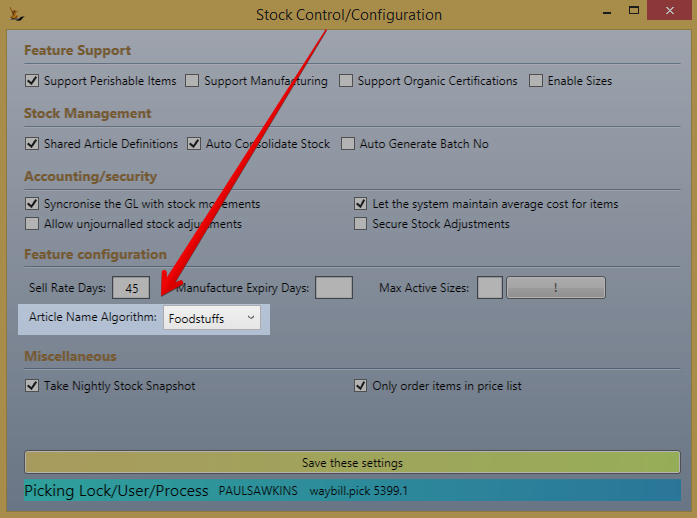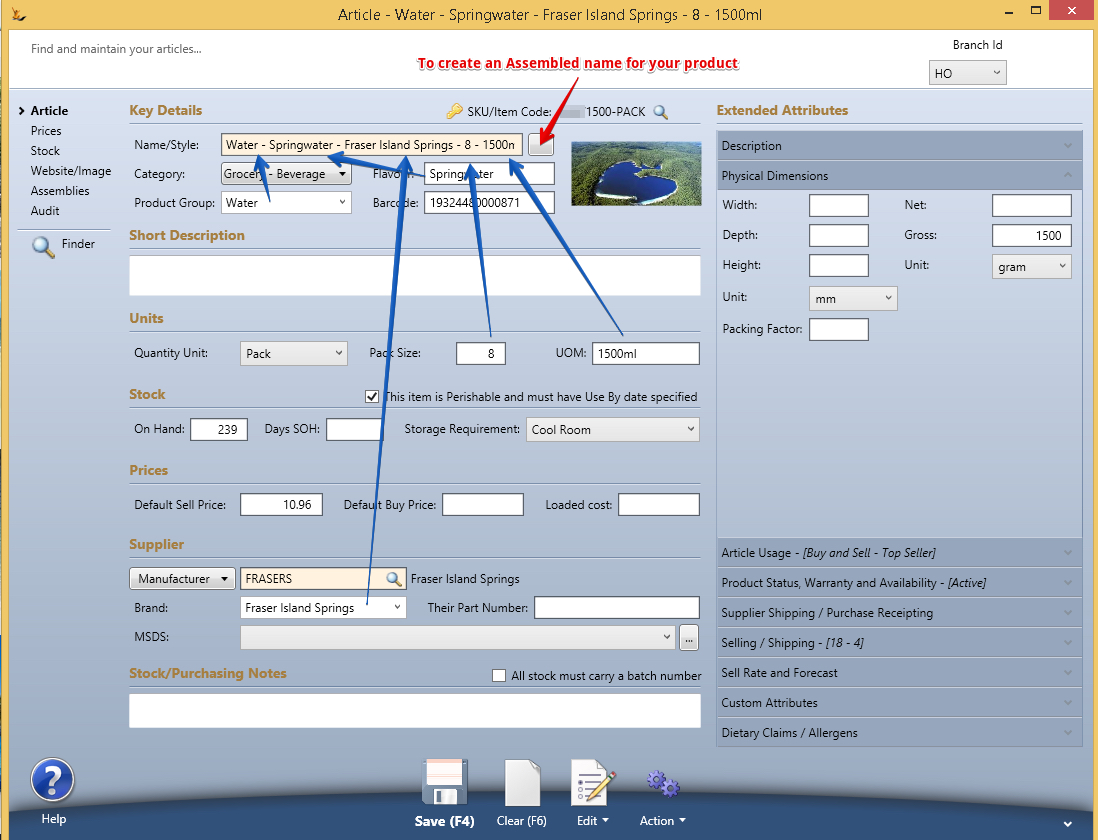| Note |
|---|
Clothing companies see Managing Clothing Articles |
| Table of Contents |
|---|
Overview
...
Standardising the Article Name (Food) - Stock Control Configuration
The Articles can have standardised names made up of pieces of information about the article. This is useful when a logical internal name can carry information to help users. There are a number of name algorithms and if you have a preferred one talk to us.
I the below example the Article Name is then made up from pieces to get a consistent naming convention (Eg Foodstuffs)There are multiple ways to assemble a name - and we can easily add more if you have special requirements.
Article Tab
General information about this Article
- SKU/Item Code (is stock keeping unit) is also search code. Use this field to Useful things to know#Searching in the system for an Article you are looking for.
- Note changing SKU/Item Codes can only be done by persons with the Secure Feature of "Can Maintain Article Details" when it has a qualifier >0
- Name is commonly displayed as well as SKU in the system
- Description
- Category is used in a number of areas in the system and is setup in Article Categories where you can see all the items that belong to a particular category.
- Purchasing
- Portal
- Webstore
- Quantity Unit is the base unit of measure
- each
- bulk/pack (allows product weight per pack to vary)
- Pack - is made up of components
- Other - eg dual units of measure (meats, cheese etc) or lengths (wood, metal etc)
- On Hand is the current total quantity of the item in stock in this entity - have a look at Article#Stock Tab for details across warehouses / Franchises
- On Sales order is the current quantity that has been committed in the system but have not yet been shipped. To be included the order must be committed
- Storage requirement will limit the stock locations available to those that comply with the storage requirement
- ETA is expected date for next arrival of a purchase order
- Barcode is an alphanumeric field to store the barcode definition
- Price GST indicates if this Article is generally sold as GST-inc.inc
- Default Value Price is a value that can be used if a different estimate of the value of inventory is of interest than the inventory standard cost
- Buy / Sell Setting indicates if it can be purchased, sold or is only an internal item
- Buy / Sell GL accounts can be used to over-ride the defaults held at supplier or GL Control Accounts
- Purchase multiples can be specified using Quantity price breaks
- Supplier factory - if a supplier has multiple factories then purchase orders will limit to the factory
- Pallet arrangements with units per layer, layers per unit from supplier, for storage and to ship can all be held
- Shopping cart status - featured, new, top seller, hidden
- Country of Origin - used for international sales orders to indicate country of origin
- Export Description - where a different item description is desired for export orders
- Product Status
- Active
- Proposed - cannot yet be sold - but can be placed on sales orders to indicate possible demand - see Managing Clothing Articles
- Runout (until sold) cannot be added to purchase orders and is not planned by Product Forecasting - Based on Sales History
- Hold (Temporary) - visible on sales orders and purchase orders however cannot be added
- Inactive - only found when searching for inactive products
- Default Buy Price is the default price to use on Purchase orders
- Default Sell Price is the default price to use if no other price list applies to the order
- Note that if there is no default sell price the item will not be found by the sales order when looking up items unless there is a sell price volume price break
- Average cost - is a rolling average and updated by Landed Costing
- EPA container quantity is used for Container Deposit Scheme reporting
- Mass is used for planning Cartonising process, delivery vehicle weight planning, Landed Cost allocations
- Net Mass is the item only
- Gross Mass is the item plus packaging
- Physical Dimensions is also use for planning Cartonising process, delivery vehicle volume planning, Landed Cost allocations
- Width, Depth, Height, Packing Factor (for items that pack below their cube volume)
- GL Account is the default GL account to use when selling this item
- Manufacturer is the default manufacturer for this item and is used in Purchase Orders to reduce the lists of items by manufacturer when required
- Their Part Number outlines the part number that is used by the supplier and placed on the purchase order sent to the supplier
- Brand is the suppliers brand - or house brand for the product
- Range is the product range within the product brand where this applies
- Spec / MSDS links to documents held in the system that may be referenced by multiple Articles
- Product Livespan and Available Warrantee
- Not available before or after limits ability to use the Article in sales and purchase orders, it can still be used however warnings will make it more difficult to use
- Warranty Period (months) - duration of customer warrantee from purchase
- Supplier warrantee period (months) - duration of customer warrantee from purchase that supplier will cover
- Serial Mode
- Generated on sale
- Aquired on sale
- Generated on Receipt or manufacture
- Aquired on Recept or manufacture
- Private SKU Owner - Stock Article will only be visible to
- An individual debtor - if entered
- A buying group member - All Debtors linked to the buying group will be able to purchase this product
- State Availability
- If no states are ticked - the stock is available in all states
- If some states are ticked - the stock is only available in those states
- Replenishment quantity is default quantity for replenishment of pickface
- lead times for PO to Delivery, Quarantine can over-ride supplier defaults
- Maximum shelf life - reduces errors in data entry
- Sell rates are calculated regularly by warehouse / retail store
- Default expiry days, useby horizon days (min useby days for customers), distributor horizon days - all can over-ride defaults from the supplier that can overide defaults on Maintain Stock Control Settings
- NIP (If Expiry Dated products)
...
- Quantity Discounts is a sales discount and enables this item to have a discounted price when a particular quantity is reached on a sales order.
- Quantity that must be purchased minimum
- Unit price Price Lists limits this quantity discount to those who qualify for a particular Price Lists/wiki/spaces/SI/pages/33054894
- Order Qty must be in Qty Discount Multiples will limit the quantities that can be ordered and receive discounts to multiples of the qty discount
- Price List grid shows the pricing by Price Lists/wiki/spaces/SI/pages/33054894
- Price
- Maximum Quantity is used by the portal to ensure order quantities are not above a certain value
- Price list this relates to
- Buy or Sell determines where it is available in the system
- Buy - available on Purchase Orders
- Sell - available on sales orders.
- Supplier Orders
- Shipping unit (buy) is the units that are used for purchasing
- Cartons per layer is the number of Articles per layer
- Layers per pallet
- Alternative Buy Price
- Selling or Shipping Details
- Shipping unit (sell) is the units that are used for selling
- Cartons per layer is the number of Articles per layer
- Layers per pallet
- Average cost is the current for the item based on recent purchase prices and Landed Costing
- Sell Rate and Forecast area
- '''Sell Rate Days''' is the days to look back to calculate the sell rate of an item
- '''Min Days of Stock''' shows the number of days of stock available using the Daily Sell rate and the quantity available
- '''PO to Delivery days''' is the standard time between placing an order on your supplier and receiving the stock in store
- '''Daily Sell rate''' is calculated based on the weeks to look back in history as set in Maintain Stock Control Settings Sell Rate Days and is an average assuming 7 days sales per week.
...
Shows stock on hand and enables stock additions - this does not automatically create journals and is normally only used either when the system is first put live or if the item does not have a stock value. Note that a Secure Features List and their impacts controls if a user has access to use this feature.
...

